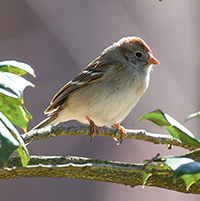Wildlife - Species
Field sparrow (Spizella pusilla)

Description
The Field sparrow is one of a group of streaked sparrows with a rust-colored cap. It is distinguished from the others by having a pinkish bill and a white eye ring. Length is about 5 inches, and the sexes are similar. The breast is clear, except in a juvenile which has a finely streaked breast. The wings have two pale white wing bars. In winter, Field sparrows may be in mixed flocks with other sparrow species such as White-throated and Song sparrows.
Voice
The Field sparrow’s song is a series of clear, high pitched notes building up to a rapid trill lasting 4 or 5 seconds. See Bird-Sounds.net for recordings of 602 species of bird calls in the U.S. and Canada. There are also a number of apps available that will identify bird sounds.
Habitat and Food
Field sparrows seek out open, brushy habitat such as overgrown fields and pastures, and openings in wooded areas. They like low perches such as shrubs and fencerows. They feed on small seeds, especially grass seeds, and a wide range of insects when the weather warms. They can often be seen hopping on the ground while feeding, and lighting on taller grasses to push the stem to the ground for easier seed extraction.
Nesting
Field sparrows are year-round residents in South Carolina and most of the Southeast, however there are migratory segments to their population so there may be transient birds in the state at certain times. They have been documented to nest as many as 5 times in a single breeding season, laying 1-5 eggs in each clutch. Early nests are typically on the ground at the base of a grass clump or shrub. As the nesting season gets later, subsequent nests are built higher and higher off the ground in shrubs, vines and small trees, as much as 10 feet high. Field sparrows usually shy away from human habitation when selecting nest sites, and the nest is an open cup 1-3 inches in depth. They are almost always monogamous (same pair stays together through the nesting season).
Additional Information
Amy Tegeler – Bird Conservation Coordinator
SCDNR
P.O. Box 23205
Columbia, SC 29224
Phone: (803) 521-2119
E-mail: TegelerA@dnr.sc.gov
